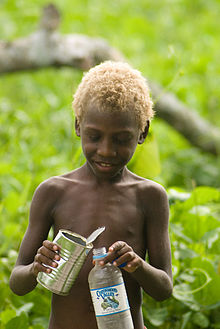 A young Ni-Vanuatu boy. | |
| Total population | |
|---|---|
| c. 300,000 | |
| Regions with significant populations | |
| Vanuatu c. 270,000 | |
| Languages | |
| English, French, Bislama, over 100 Oceanic languages | |
| Religion | |
| Christian (Presbyterian, Anglican, Roman Catholic), Animism | |
| Related ethnic groups | |
| other Melanesian peoples |
Ni-Vanuatu (informally abbreviated Ni-Van) is a large group of closely related Melanesian ethnic groups native to the island country of Vanuatu. As such, ni-Vanuatu are a mixed ethnolinguistic group with a shared ethnogenesis that speak a multitude of languages.[1][2][3][4]
The ni-Vanuatu or ni-Van is usually restricted to the indigenous population of Vanuatu. It contrasts with the demonym Vanuatuan, which in principle refers to any citizen of Vanuatu, regardless of their origin or ethnicity. (The form Vanuatuan is in fact rarely used in English, and is regarded as incorrect by some authors and style guides.[5][6][7])
Due to the history of British and French colonialism, indigenous people of Vanuatu generally speak English and French, as well as Bislama.[8]
The cultural aspects of ni-Vanuatu society have been instilled on the indigenous community and are expressed through clothing, rituals, ceremonies, music, performing and fine arts, and cuisine.[9] The spiritual ties ni-Vanuatu have with their land and ancestors are conveyed through these traditions and some of these remaining artefacts have been preserved and displayed in the galleries of Vanuatu.
- ^ "RAMSI Mourns Death of Senior Ni-Vanuatu Police Officer". Solomon Times. 28 April 2009. Retrieved 30 August 2011.
- ^ "Ni-Vanuatu arrested NZ"[permanent dead link], Radio Vanuatu, 10 March 2009
- ^ "Des Ni-Vanuatu en final des Masters"[permanent dead link], Agence universitaire francophone, 31 July 2008
- ^ "Ni-Vanuatu workers employed under RSE scheme set to increase". Radio New Zealand International. 18 February 2008. Retrieved 30 October 2011.
- ^ Rowlings, Gregory (2016). "Asymmetrical ambiguities: the 'White Australia policy', travel, migration and citizenship in Vanuatu, 1945–1953". In Leckie, Jacqueline; McCarthy, Angela; Wanhalla, Angela (eds.). Migrant Cross-Cultural Encounters in Asia and the Pacific. London: Taylor and Francis. ISBN 9781317096672.
- ^ Fenelon, Judy (2002). AusAID style guide (PDF). Australian Agency for International Development. p. 79. OCLC 225052411. Archived from the original (PDF) on 17 April 2012. Retrieved 14 November 2018.
- ^ "V". Guardian and Observer style guide. Guardian Media Group. 5 November 2015. Retrieved 14 November 2018.
- ^ Cite error: The named reference
:12was invoked but never defined (see the help page). - ^ Cite error: The named reference
:6was invoked but never defined (see the help page).